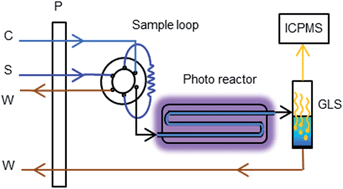Online photochemical vapour generation of inorganic tin for inductively coupled plasma mass spectrometric detection
Abstract
Photochemical vapour generation (PCVG) as a sample introduction technique was adopted, for the first time, for the quantitative determination of trace levels of inorganic tin with inductively coupled plasma mass spectrometry (ICPMS). Volatile tin species could be generated online when a solution of stannous or stannic chloride containing acetic acid was pumped into a laboratory-built high-efficiency photochemical reactor using a flow injection (FI) system. The gaseous products generated were separated from the liquid phase within a gas–liquid separator (GLS), and subsequently transported to ICPMS for tin detection. After investigation and optimisation of the PCVG and ICPMS conditions, highly repeating tin signals were obtained, with the highest signal-to-noise ratios achieved to date recorded using 0.8% acetic acid as the reaction medium with an irradiation time of 32 s and an Ar gas flow-rate of 0.90 L min−1 for GLS. The method precision represented with the relative standard derivation (RSD) was 4.5% (0.1 μg L−1, n = 5), and the limit of quantification (LOQ, 10σ) was 0.02 μg L−1 under the optimised conditions. Surface water samples were used to test the developed method in a real world sample analysis.


 Please wait while we load your content...
Please wait while we load your content...